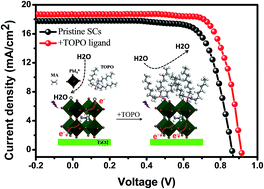Post-healing of defects: an alternative way for passivation of carbon-based mesoscopic perovskite solar cells via hydrophobic ligand coordination†
Abstract
The passivation of defects at perovskite grain boundaries (GB) is crucial in achieving highly efficient and stable perovskite solar cells. Unlike the widely used additive passivation method where a mixture of additives and perovskite precursor is used for preparing perovskite films, we herein developed a new defect post-healing method via dip-coating trioctylphosphine oxide (TOPO) ligands on pre-fabricated carbon-based mesoscopic perovskite solar cells (MPSCs). Since perovskites have formed before post-healing, TOPO ligands are selectively adsorbed onto the exposed perovskite surface and hence have little influence on charge extraction of interfaces. The defects are post-healed via O atoms in P![[double bond, length as m-dash]](https://www.rsc.org/images/entities/char_e001.gif) O bonds coordinated to halide-deficient sites, leading to an enhancement of the power conversion efficiency (PCE) from 11.0% to 12.8%. Moreover, due to the three hydrophobic long chain alkyls in TOPO, the humidity stability of the device has also been improved simultaneously.
O bonds coordinated to halide-deficient sites, leading to an enhancement of the power conversion efficiency (PCE) from 11.0% to 12.8%. Moreover, due to the three hydrophobic long chain alkyls in TOPO, the humidity stability of the device has also been improved simultaneously.



 Please wait while we load your content...
Please wait while we load your content...